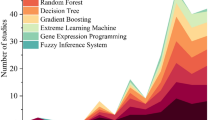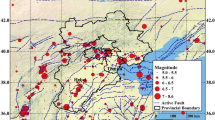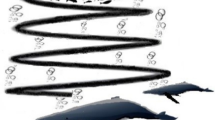Abstract
Self-potential (SP) method has been widely used to identify some geological structures related to electrical potential. Multiple sources of anomalies give some difficulty in SP data inversion or interpretation due to a high number of model parameters. This paper proposes enhanced Runge–Kutta optimization (ERUN) using a rank-based mechanism and the chaotic logistic map to balance exploration and exploitation ability for multiple anomalies of SP data inversion in determining SP model parameters. ERUN is compared to the RUN algorithm on SP inversion problem with multiple anomalies. Model parameters are estimated using a posterior distribution model with the applied threshold. The result shows that RUN and ERUN can provide uncertainty analysis using the posterior distribution model. Furthermore, ERUN and RUN are applied to solve synthetic and field data. ERUN and RUN yield good results and show good agreement with geologic information. Model parameters generated by ERUN and RUN are appropriate for validation with prior researchers. LUSI embankment assessment using SP method analyzed using RUN and ERUN algorithm shows that ERUN has more reasonable result than RUN. Overall, ERUN is relatively more reliable in solving SP inversion problems with a relatively high number of anomalies than other algorithms tested in this research. This advantage comes with a relatively high computational cost, which makes ERUN slower.




















Similar content being viewed by others
References
Abdelrahman E M, Saber H S, Essa K S and Fouda M A 2004 A least-squares approach to depth determination from numerical horizontal self-potential gradients; Pure Appl. Geophys. 2 399–411, https://doi.org/10.1007/s00024-003-2446-5.
Ahmadianfar I, Heidari A A, Gandomi A H, Chu X and Chen H 2021 RUN beyond the metaphor: An efficient optimization algorithm based on Runge Kutta method; Expert Syst. Appl. 115079, https://doi.org/10.1016/j.eswa.2021.115079.
Al-Saigh N H, Mohammed Z S and Dahham M S 1994 Detection of water leakage from dams by self-potential method; Eng. Geol. 2 115–121, https://doi.org/10.1016/0013-7952(94)90046-9.
Balkaya Ç 2013 An implementation of differential evolution algorithm for inversion of geoelectrical data; J. Appl. Geophys. 98 160–175, https://doi.org/10.1016/j.jappgeo.2013.08.019.
Barhen J, Berryman J G, Borcea L, Dennis J, de Groot-Hedli C, Gilbert F, Gill P, Heinkenschloss M, Johnson L, McEvilly T, More J, Newman G, Oldenburg D, Parker P, Porto B, Sen M, Torczon V, Vasco D and Woodward N B Optimization and geophysical inverse problems; United States, https://doi.org/10.2172/939130.
Biswas A and Sharma S P 2014a Optimization of self-potential interpretation of 2-D inclined sheet-type structures based on very fast simulated annealing and analysis of ambiguity; J. Appl. Geophys. 105 235–247, https://doi.org/10.1016/j.jappgeo.2014.03.023.
Biswas A and Sharma S P 2014b Interpretation of self-potential anomaly over idealized bodies and analysis of ambiguity using very fast simulated annealing global optimization technique; Near Surf. Geophys. 2 179–195, https://doi.org/10.3997/1873-0604.2015005.
Biswas A, Rao K and Biswas A 2022 Inversion and uncertainty estimation of self-potential anomalies over a two-dimensional dip** layer/bed: Application to mineral exploration, and archaeological targets; Minerals 12 1484, https://doi.org/10.3390/min12121484.
Chen H, Ahmadianfar I, Liang G, Bakhsizadeh H, Azad B and Chu X 2022 A successful candidate strategy with Runge–Kutta optimization for multi-hydropower reservoir optimization; Expert Syst. Appl. 209(2) 118383, https://doi.org/10.1016/j.eswa.2022.118383.
Cheng S, Shi Y, Qin Q, Zhang Q and Bai R 2014 Population diversity maintenance in brain storm optimization algorithm; J. Artif. Intell. Soft Comput. 2 83–97, https://doi.org/10.1515/jaiscr-2015-0001.
Cui Y, Zhu X, Wei W, Liu J and Tong T 2017 Dynamic imaging of metallic contamination plume based on self-potential data; Trans. Nonferrous Met. Soc. China 8 1822–1830, https://doi.org/10.1016/s1003-6326(17)60205-x.
Dmitriev A N 2012 Forward and inverse self-potential modeling: A new approach; Russian Geol. Geophys. 6 611–622, https://doi.org/10.1016/j.rgg.2012.04.008.
Dobrin M B and Savit C H 1988 Introduction to geophysical prospecting; McGraw-Hill College.
Elhussein M 2020 A novel approach to self-potential data interpretation in support of mineral resource development; Nat. Resour. Res. 1 97–127, https://doi.org/10.1007/s11053-020-09708-1.
Essa K S 2011 A new algorithm for gravity or self-potential data interpretation; J. Geophys. Eng. 3 434–446, https://doi.org/10.1088/1742-2132/8/3/004.
Essa K S, Diab Z E and Mehanee S A 2022 Self-potential data inversion utilizing the Bat Optimizing Algorithm (BOA) with various application cases; Acta Geophys. 2 567–586, https://doi.org/10.1007/s11600-022-00955-9.
Fedi M and Abbas M A 2013 A fast interpretation of self-potential data using the depth from extreme points method; Geophysics 2 E107–E116, https://doi.org/10.1190/geo2012-0074.1.
Fernández-Martínez J L, Fernández-Muñiz Z, Pallero J L G and Pedruelo-González L M 2013 From Bayes to Tarantola: New insights to understand uncertainty in inverse problems; J. Appl. Geophys. 98 62–72, https://doi.org/10.1016/j.jappgeo.2013.07.005.
Fernández-Martínez J L, Pallero J L G, Fernández-Muñiz Z and Pedruelo-González L M 2014a The effect of noise and Tikhonov’s regularization in inverse problems. Part I: The linear case; J. Appl. Geophys. 108 176–185, https://doi.org/10.1016/j.jappgeo.2014.05.006.
Fernández-Martínez J L, Pallero J L G, Fernández-Muñiz Z and Pedruelo-González L M 2014b The effect of noise and Tikhonov’s regularization in inverse problems. Part II: The nonlinear case; J. Appl. Geophys. 108 186–193, https://doi.org/10.1016/j.jappgeo.2014.05.005.
Göktürkler G and Balkaya Ç 2012 Inversion of self-potential anomalies caused by simple-geometry bodies using global optimization algorithms; J. Geophys. Eng. 5 498–507, https://doi.org/10.1088/1742-2132/9/5/498.
Guo Y, Cui Y, **e J, Luo Y, Zhang P, Liu H and Liu J 2022 Seepage detection in earth-filled dam from self-potential and electrical resistivity tomography; SSRN Electron. J., https://doi.org/10.2139/ssrn.4093942.
Haryono A, Sungkono Agustin R, Santosa B J, Widodo A and Ramadhany B 2020 Model parameter estimation and its uncertainty for 2-D inclined sheet structure in self-potential data using crow search algorithm; Acta Geodyn. Geophys. 4 691–715, https://doi.org/10.1007/s40328-020-00321-5.
Heritiana A R, Riva R, Ralay R and Boni R 2019 Evaluation of flake graphite ore using self-potential (SP), electrical resistivity tomography (ERT) and induced polarization (IP) methods in east coast of Madagascar; J. Appl. Geophys. 169 134–141, https://doi.org/10.1016/j.jappgeo.2019.07.001.
Hussain K, Salleh M N M, Cheng S and Shi Y 2018 On the exploration and exploitation in popular swarm-based metaheuristic algorithms; Neural. Comput. Appl. 11 7665–7683, https://doi.org/10.1007/s00521-018-3592-0.
Lupi M, Saenger E H, Fuchs F and Miller S A 2013 Lusi mud eruption triggered by geometric focusing of seismic waves; Nat. Geosci. 8 642–646, https://doi.org/10.1038/ngeo1884.
Mazzini A, Nermoen A, Krotkiewski M, Podladchikov Y, Planke S and Svensen H 2009 Strike-slip faulting as a trigger mechanism for overpressure release through piercement structures. Implications for the Lusi mud volcano, Indonesia; Mar. Pet. Geol. 9 1751–1765, https://doi.org/10.1016/j.marpetgeo.2009.03.001.
Mehanee S A 2014 An efficient regularized inversion approach for self-potential data interpretation of ore exploration using a mix of logarithmic and non-logarithmic model parameters; Ore Geol. Rev. 57 87–115, https://doi.org/10.1016/j.oregeorev.2013.09.002.
Mehanee S A, Essa K S, Soliman K S and Diab Z E 2023 A fast imaging method for the interpretation of self-potential data with application to geothermal systems and mineral investigation; Sci. Rep. 1, https://doi.org/10.1038/s41598-023-39672-8.
Menke W 2012 Geophysical data analysis: Discrete inverse theory; Academic Press.
Monteiro Santos F A 2010 Inversion of self-potential of idealized bodies’ anomalies using particle swarm optimization; Comput. Geosci. 9 1185–1190, https://doi.org/10.1016/j.cageo.2010.01.011.
Moore J R, Boleve A, Sanders J W and Glaser S D 2011 Self-potential investigation of moraine dam seepage; J. Appl. Geophys. 4 277–286, https://doi.org/10.1016/j.jappgeo.2011.06.014.
Naudet V 2003 Relationship between self-potential (SP) signals and redox conditions in contaminated groundwater; Geophys. Res. Lett. 30(21) 2091, https://doi.org/10.1029/2003gl018096.
Nourbehecht B 1992 Irreversible thermodynamic effects in inhomogeneous media and their applications in certain geoelectric problems; Massachusetts Institute of Technology, 242p.
Pallero J L G, Fernández-Martínez J L, Bonvalot S and Fudym O 2015 Gravity inversion and uncertainty assessment of basement relief via particle swarm optimization; J. Appl. Geophys. 116 180–191, https://doi.org/10.1016/j.jappgeo.2015.03.008.
Rani P, Piegari E, Di Maio R, Vitagliano E, Soupios P and Milano L 2019 Monitoring time evolution of self-potential anomaly sources by a new global optimization approach: Application to organic contaminant transport; J. Hydrol. 955–964, https://doi.org/10.1016/j.jhydrol.2019.05.093.
Rao K, Jain S and Biswas A 2020 Global optimization for delineation of self-potential anomaly of a 2D inclined plate; Nat. Resour. Res. 1 175–189, https://doi.org/10.1007/s11053-020-09713-4.
Reddi A B, Madhusudan I C, Sarkar B and Sharma J K 1982 An album of geophysical responses from base metal belts of Rajasthan and Gujarat; Miscellaneous Publication-GS I 51p.
Revil A and Jardani A 2013 The self-potential method; Cambridge University Press.
Reynolds J M 2011 An introduction to applied and environmental geophysics; Wiley.
Shaban H, Houssein E H, Pérez-Cisneros M, Oliva D, Hassan A Y, Ismaeel A A K, AbdElminaam D S, Deb S and Said M 2021 Identification of parameters in photovoltaic models through a Runge Kutta optimizer; Mathematics 18 2313, https://doi.org/10.3390/math9182313.
Sindirgi P and Özyalin Ş 2021 A comparison of the model parameter estimations from self-potential anomalies by Levenberg–Marquardt (LM), differential evolution (DE) and particle swarm optimization (PSO) algorithms: An example from Tamış–Çanakkale, Turkey; In: Self-potential method: Theoretical modeling and applications in geosciences, Springer International Publishing, pp. 133–153, https://doi.org/10.1007/978-3-030-79333-3_4.
Soueid Ahmed A, Jardani A, Revil A and Dupont J P 2013 SP2DINV: A 2D forward and inverse code for streaming potential problems; Comput. Geosci. 59 9–16, https://doi.org/10.1016/j.cageo.2013.05.008.
Srivastava S and Agarwal B N P 2009 Interpretation of self-potential anomalies by enhanced local wave number technique; J. Appl. Geophys. 2 259–268, https://doi.org/10.1016/j.jappgeo.2008.11.011.
Sungkono 2020a Robust interpretation of single and multiple self-potential anomalies via flower pollination algorithm; Arab. J. Geosci. 3, https://doi.org/10.1007/s12517-020-5079-4.
Sungkono 2020b An efficient global optimization method for self-potential data inversion using micro-differential evolution; J. Earth Syst. Sci. 129 178, https://doi.org/10.1007/s12040-020-01430-z.
Sungkono, Husein A, Prasetyo H, Bahri A S, Monteiro Santos F A and Santosa B J 2014 The VLF-EM imaging of potential collapse on the LUSI embankment; J. Appl. Geophys. 109 218–232, https://doi.org/10.1016/j.jappgeo.2014.08.004.
Sungkono, Feriadi Y, Husein A, Prasetyo H, Charis M, Irawan D, Rochman J P G N, Bahri A S and Santosa B J 2018 Assessment of Sidoarjo mud flow embankment stability using very low frequency electromagnetic method; Environ. Earth Sci. 5, https://doi.org/10.1007/s12665-018-7333-6.
Sungkono S, Wasilah M N, Widyaningrum Y, Hidayatullah W M, Fathoni F A and Husein A 2020 Self-potential method to assess embankment stability: A study related to the Sidoarjo mud flow; J. Eng. Technol. Sci. 5 707, https://doi.org/10.5614/j.eng.technol.sci.2020.52.5.8.
Sungkono, Apriliani E, Saifuddin Fajriani and Srigutomo W 2021 Ensemble Kalman inversion for determining model parameter of self-potential data in the mineral exploration; In: Self-potential method: Theoretical modeling and applications in geosciences, Springer International Publishing, pp. 179–202, https://doi.org/10.1007/978-3-030-79333-3_7.
Tang L, Dong Y and Liu J 2015 Differential evolution with an individual-dependent mechanism; IEEE Trans. Evol. Comput. 4 560–574, https://doi.org/10.1109/tevc.2014.2360890.
Tingay M, Heidbach O, Davies R and Swarbrick R 2008 Triggering of the Lusi mud eruption: Earthquake versus drilling initiation; Geology 36(8) 639–642, https://doi.org/10.1130/g24697a.1.
Tlas M and Asfahani J 2012 An approach for interpretation of self-potential anomalies due to simple geometrical structures using fair function minimization; Pure Appl. Geophys. 5 895–905, https://doi.org/10.1007/s00024-012-0594-1.
Touzani M, Mohsine I, Ouardi J, Kacimi I, Morarech M, El Bahajji M, Bouramtane T, Tiouiouine A, Yameogo S and El Mahrad B 2021 Map** the pollution plume using the self-potential geophysical method: Case of Oum Azza landfill, Rabat, Morocco; Water 7 961, https://doi.org/10.3390/w13070961.
Wolpert D H and Macready W G 1997 No free lunch theorems for optimization; IEEE Trans. Evol. Comput. 1 67–82, https://doi.org/10.1109/4235.585893.
**e J, Cui Y, Fanidi M, Zhang L, Guo Y, Luo Y and Liu J 2021 Numerical modeling of marine self-potential from a seafloor hydrothermal ore deposit; Pure Appl. Geophys., https://doi.org/10.1007/s00024-021-02720-3.
Funding
Funding is provided by Direktorat Riset Dan Pengabdian Kepada Masyarakat (1541/PKS/ITS/2022) for this research.
Author information
Authors and Affiliations
Contributions
Agung Nugroho Ramadhan: Conceptualization, methodology, software, writing – original draft preparation, visualization, validation, formal analysis. Sungkono: Data curation, validation, formal analysis. Alif Muftihan Rizaq: Validation, formal analysis. Dheo Callisto Furi: Writing – review and editing. Dwa Desa Warnana: Data curation.
Corresponding author
Additional information
Communicated by Arkoprovo Biswas
Corresponding editor: Arkoprovo Biswas
Rights and permissions
Springer Nature or its licensor (e.g. a society or other partner) holds exclusive rights to this article under a publishing agreement with the author(s) or other rightsholder(s); author self-archiving of the accepted manuscript version of this article is solely governed by the terms of such publishing agreement and applicable law.
About this article
Cite this article
Ramadhan, A.N., Sungkono, Rizaq, A.M. et al. Multi-anomalies self-potential inversion using enhanced Runge–Kutta optimization. J Earth Syst Sci 133, 14 (2024). https://doi.org/10.1007/s12040-023-02225-8
Received:
Revised:
Accepted:
Published:
DOI: https://doi.org/10.1007/s12040-023-02225-8




